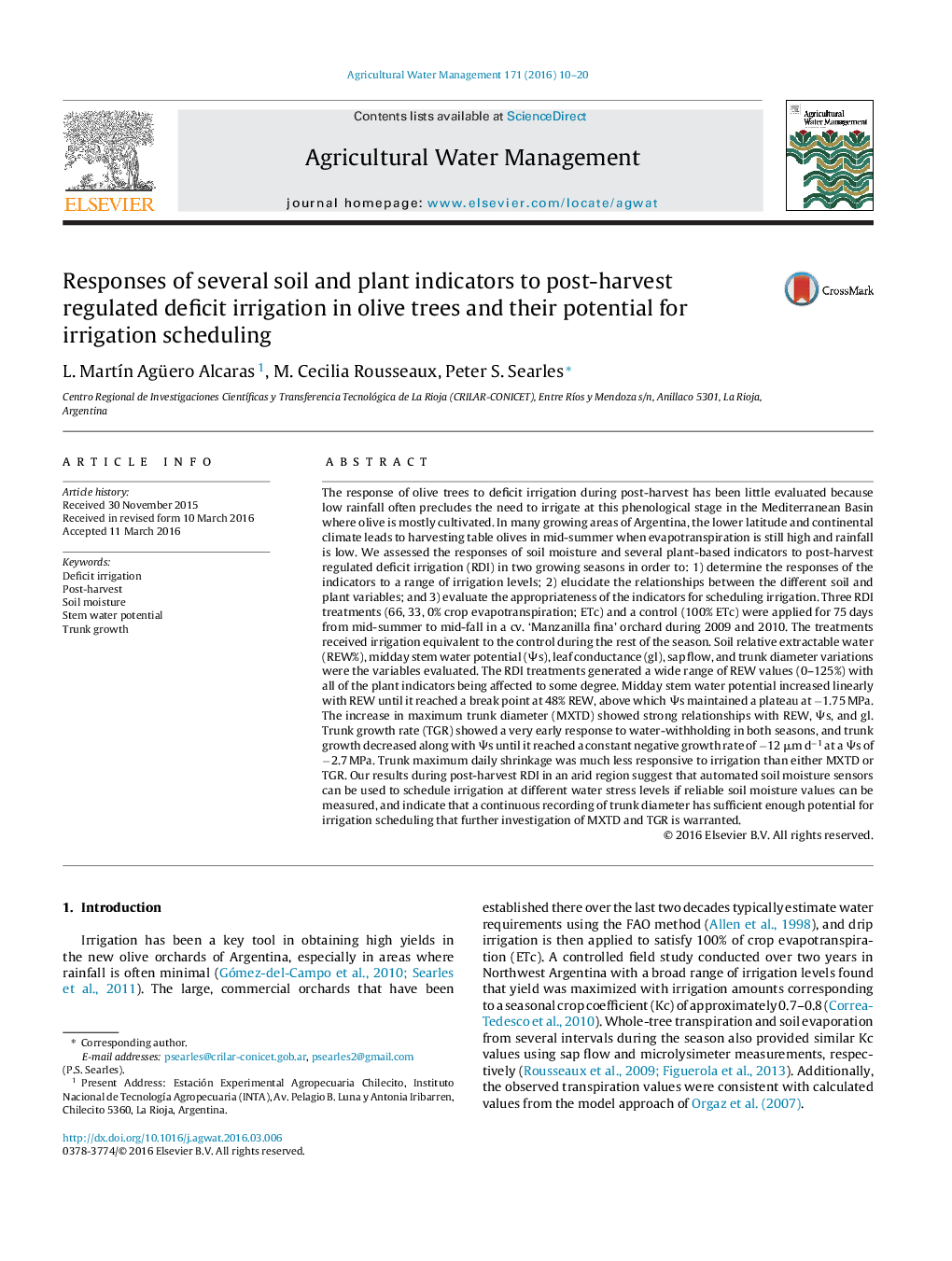| کد مقاله | کد نشریه | سال انتشار | مقاله انگلیسی | نسخه تمام متن |
|---|---|---|---|---|
| 6363474 | 1622909 | 2016 | 11 صفحه PDF | دانلود رایگان |
عنوان انگلیسی مقاله ISI
Responses of several soil and plant indicators to post-harvest regulated deficit irrigation in olive trees and their potential for irrigation scheduling
ترجمه فارسی عنوان
پاسخ چندین شاخص خاک و گیاه به آبیاری کم آب مقرر شده پس از برداشت درختان زیتون و پتانسیل آنها برای برنامه ریزی آبیاری
دانلود مقاله + سفارش ترجمه
دانلود مقاله ISI انگلیسی
رایگان برای ایرانیان
کلمات کلیدی
آبیاری کمبود، پس از برداشت، رطوبت خاک، پتانسیل آب ساقه، رشد تنه
موضوعات مرتبط
علوم زیستی و بیوفناوری
علوم کشاورزی و بیولوژیک
علوم زراعت و اصلاح نباتات
چکیده انگلیسی
The response of olive trees to deficit irrigation during post-harvest has been little evaluated because low rainfall often precludes the need to irrigate at this phenological stage in the Mediterranean Basin where olive is mostly cultivated. In many growing areas of Argentina, the lower latitude and continental climate leads to harvesting table olives in mid-summer when evapotranspiration is still high and rainfall is low. We assessed the responses of soil moisture and several plant-based indicators to post-harvest regulated deficit irrigation (RDI) in two growing seasons in order to: 1) determine the responses of the indicators to a range of irrigation levels; 2) elucidate the relationships between the different soil and plant variables; and 3) evaluate the appropriateness of the indicators for scheduling irrigation. Three RDI treatments (66, 33, 0% crop evapotranspiration; ETc) and a control (100% ETc) were applied for 75 days from mid-summer to mid-fall in a cv. 'Manzanilla fina' orchard during 2009 and 2010. The treatments received irrigation equivalent to the control during the rest of the season. Soil relative extractable water (REW%), midday stem water potential (Ψs), leaf conductance (gl), sap flow, and trunk diameter variations were the variables evaluated. The RDI treatments generated a wide range of REW values (0-125%) with all of the plant indicators being affected to some degree. Midday stem water potential increased linearly with REW until it reached a break point at 48% REW, above which Ψs maintained a plateau at â1.75 MPa. The increase in maximum trunk diameter (MXTD) showed strong relationships with REW, Ψs, and gl. Trunk growth rate (TGR) showed a very early response to water-withholding in both seasons, and trunk growth decreased along with Ψs until it reached a constant negative growth rate of â12 μm dâ1 at a Ψs of â2.7 MPa. Trunk maximum daily shrinkage was much less responsive to irrigation than either MXTD or TGR. Our results during post-harvest RDI in an arid region suggest that automated soil moisture sensors can be used to schedule irrigation at different water stress levels if reliable soil moisture values can be measured, and indicate that a continuous recording of trunk diameter has sufficient enough potential for irrigation scheduling that further investigation of MXTD and TGR is warranted.
ناشر
Database: Elsevier - ScienceDirect (ساینس دایرکت)
Journal: Agricultural Water Management - Volume 171, June 2016, Pages 10-20
Journal: Agricultural Water Management - Volume 171, June 2016, Pages 10-20
نویسندگان
L. MartÃn Agüero Alcaras, M. Cecilia Rousseaux, Peter S. Searles,
